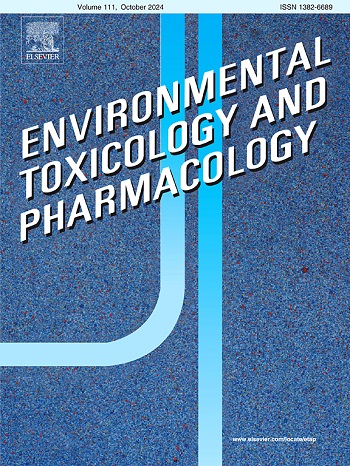The dithiocarbamate pesticides maneb and mancozeb disturb the metabolism of lipids and xenobiotics in an in vitro model of metabolic dysfunction-associated steatotic liver disease
IF 4.2
3区 环境科学与生态学
Q2 ENVIRONMENTAL SCIENCES
引用次数: 0
Abstract
Pesticides are increasingly recognized to be hepatotoxic, but less is known about their toxicity in metabolic dysfunction-associated steatotic liver disease (MASLD). Herein, differentiated HepaRG cells cultured for 2 weeks without (-FA) or with (+FA) a mixture of fatty acids were treated with different pesticides, including maneb and mancozeb, during the same period. While maneb and mancozeb did not induce neutral lipid accumulation in -FA-HepaRG cells, they worsened steatosis in +FA-HepaRG cells. MnCl2 treatment reproduced these effects. Maneb or MnCl2 impaired very low-density lipoprotein (VLDL) secretion and increased fatty acid uptake. Zinc supplementation restored VLDL secretion, reduced fatty acid uptake, and prevented steatosis worsening in +FA-HepaRG cells treated with mancozeb or MnCl2. Maneb, or MnCl2, also reduced the mRNA expression and activity of several cytochromes P450 in +FA- and -FA-HepaRG cells. This was associated with impaired biotransformation of diazinon. These findings could have major pathophysiological consequences in dithiocarbamate-exposed individuals with MASLD.
二硫代氨基甲酸酯农药马锰和代森锰锌在代谢功能障碍相关的脂肪变性肝病的体外模型中干扰脂质和外源物的代谢
越来越多的人认识到农药具有肝毒性,但对其在代谢功能障碍相关脂肪变性肝病(MASLD)中的毒性知之甚少。在本研究中,分化后的HepaRG细胞在不加(-FA)或加(+FA)脂肪酸混合物的情况下培养2周,在同一时间内用不同的农药处理,包括马锰和代锰锌。maneb和mancozeb在-FA-HepaRG细胞中没有诱导中性脂质积累,但它们加重了+FA-HepaRG细胞的脂肪变性。MnCl2处理重现了这些效果。Maneb或MnCl2损伤极低密度脂蛋白(VLDL)分泌并增加脂肪酸摄取。锌补充恢复VLDL分泌,减少脂肪酸摄取,并防止脂肪变性恶化的+FA-HepaRG细胞用锰锌或MnCl2处理。Maneb或MnCl2也降低了+FA-和-FA- heparg细胞中几种细胞色素P450的mRNA表达和活性。这与二嗪农的生物转化受损有关。这些发现可能对二硫代氨基甲酸盐暴露的MASLD患者具有重要的病理生理后果。
本文章由计算机程序翻译,如有差异,请以英文原文为准。
求助全文
约1分钟内获得全文
求助全文
来源期刊
CiteScore
7.00
自引率
4.70%
发文量
185
审稿时长
34 days
期刊介绍:
Environmental Toxicology and Pharmacology publishes the results of studies concerning toxic and pharmacological effects of (human and veterinary) drugs and of environmental contaminants in animals and man.
Areas of special interest are: molecular mechanisms of toxicity, biotransformation and toxicokinetics (including toxicokinetic modelling), molecular, biochemical and physiological mechanisms explaining differences in sensitivity between species and individuals, the characterisation of pathophysiological models and mechanisms involved in the development of effects and the identification of biological markers that can be used to study exposure and effects in man and animals.
In addition to full length papers, short communications, full-length reviews and mini-reviews, Environmental Toxicology and Pharmacology will publish in depth assessments of special problem areas. The latter publications may exceed the length of a full length paper three to fourfold. A basic requirement is that the assessments are made under the auspices of international groups of leading experts in the fields concerned. The information examined may either consist of data that were already published, or of new data that were obtained within the framework of collaborative research programmes. Provision is also made for the acceptance of minireviews on (classes of) compounds, toxicities or mechanisms, debating recent advances in rapidly developing fields that fall within the scope of the journal.

 求助内容:
求助内容: 应助结果提醒方式:
应助结果提醒方式:


